Scat fish are extremely hardy fish with attractive, huge spotted bodies. They come in various colors, including brown, silver, green, and red.
The red variation is rare, hence expensive, but worth every penny because of its beauty.
They belong to the genus Scatophagus of the Scatophagidae family. The meaning of “Scatophagus” is “offal-eater’ or ‘excrement eater’ because these fish often inhabits waters near floating toilets in Southeast Asia and eat everything they get access to, including what comes from those toilets. Eww…
But, fortunately, we do not have to feed them their natural food and can get along with the usual fish food for omnivore fish.
These fish are fascinating to view under clean water conditions, so they should be perfect for you if you are into fish tanks.
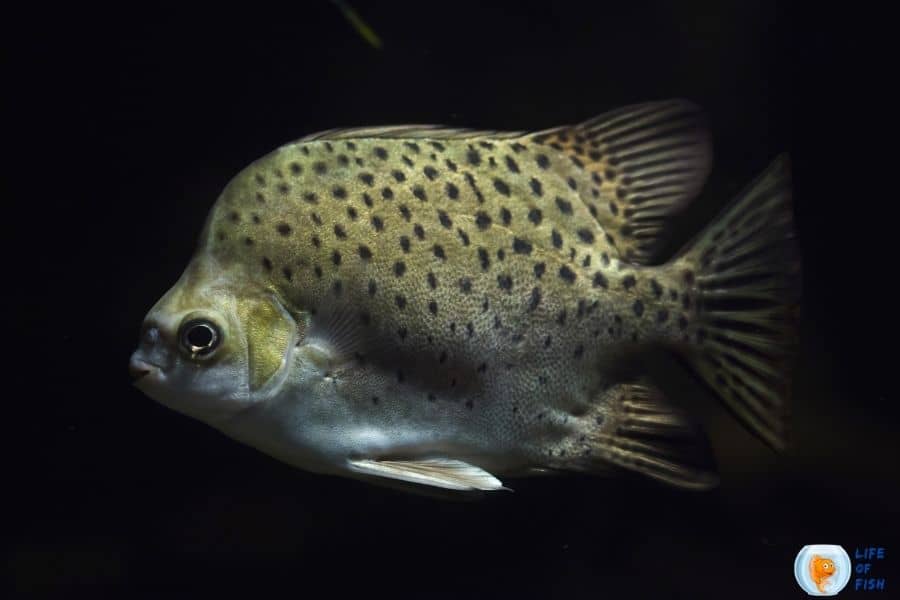
What is scat fish?
Jump To
- 1 What is scat fish?
- 2 Types of scat fish
- 3 Scat Fish Classification
- 4 Male and female scat fish
- 5 How big do scat fish get?
- 6 Is scat fish aggressive?
- 7 Scat fish behavior
- 8 How long do scat fish live?
- 9 One look care guide
- 10 Scat fish care
- 11 Scat fish breeding
- 12 Special tips
- 13 How to feed scat fish?
- 14 What fish can live with scat fish?
- 15 Related Questions
Scat Fish is a member of the family Scathophagidae that belongs to the Perciformes Order; its scientific name is (Perciformes: Scatophagidae) and also known as scats.
They inhabit harbors, estuaries, lagoons, and rivers of Southeast Asia and India.
Scat fish come in various colors, including green, brown, silver, and red with black spots and stripes.
The spotted varieties are more common than the striping ones, which is suitable for fishkeepers because they’re less expensive.
Although they can be found from different parts of the world, they are most widely available in Southeast Asia countries.
There are four types of Scat Fish, but all of them have some things in common. They’re basically omnivorous fish that can eat both plants and animal matter, making them good tank cleaners.
Types of scat fish
Spotted scat
Spotted scat (Scatophagus argus) is also known as butterfish, mia mia, spotted butterfish, tiger or green scat.
They are distributed around southern Indonesia, Papua New Guinea, north to south Japan, and south to Rowley Shoals.
green scat is usually silver with black spots on their upper body and greenish color on the back half of their body.
Their belly is white, but a blue line runs through it, giving them an attractive look. However, they also come in ruby or red color, lacking the blue line.
They will grow up to 15 inches in length and can live up to 10 years old. They’re usually peaceful fish but might turn aggressive if there isn’t enough space for each of them.
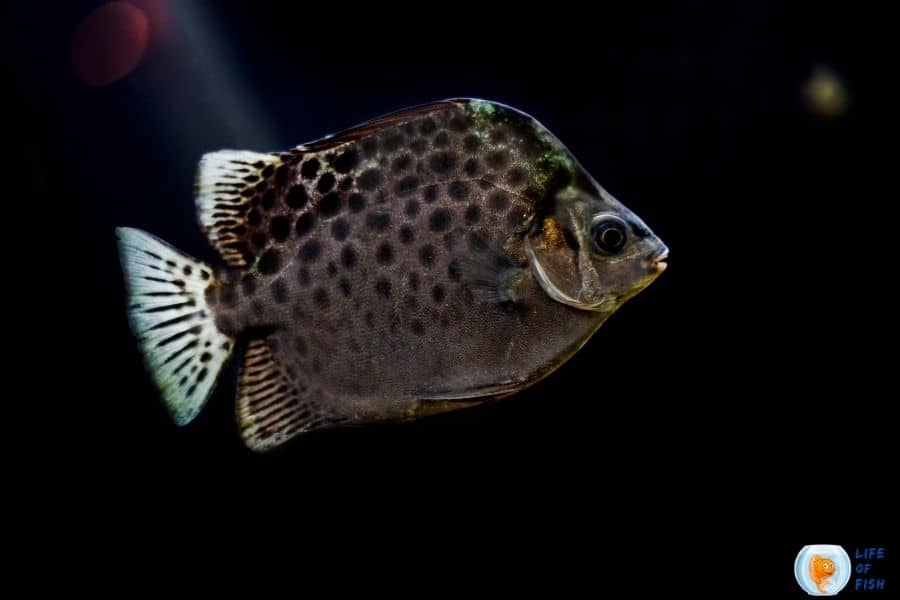
African scat
Scatophagus tetracanthus or African scat is another scat fish species native to Africa, Madagascar, New Guinea, and Australia.
They are pale cream with brown stripes from their head to the end of the body. Their forehead may have orange or red patches, which makes them look intimidating.
African scats grow up to 12 inches in length and can live for ten years under optimum care.
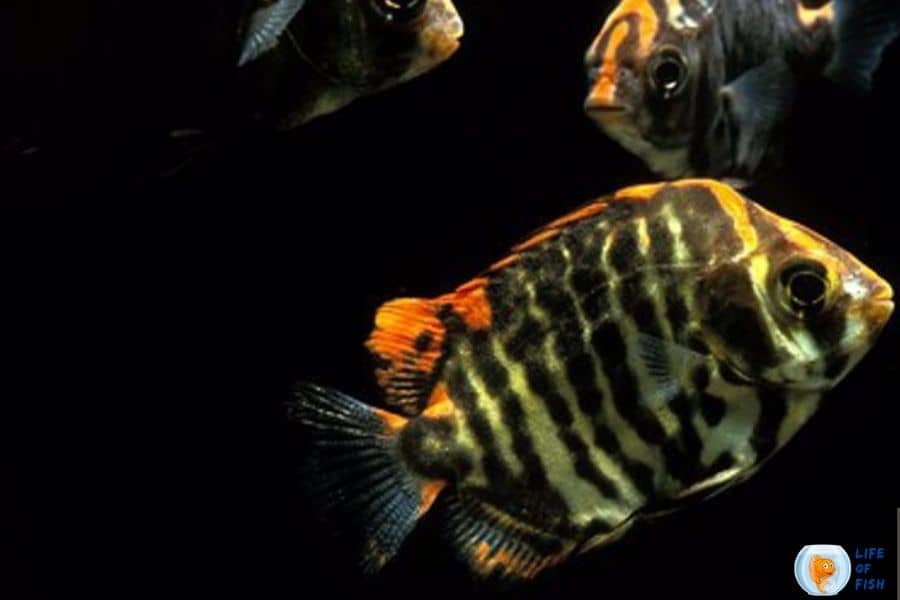
Striped scat (Spotbanded scat)
Striped scat, scientifically known as Selenotoca multifasciata, has many names, including Spotbanded scat, banded scat, butterfish, John Dory, barred scat, Johnny Dory, and old maid.
Unlike the Scatophagus genus, these fish inhabits marine waters in the Indian Ocean and Southeastern Pacific Ocean.
Like their name Spotbanded Scat, they have both spots and bands on their body. They are usually brown or green on top with white on the bottom of their body.
Brown stripes stretch from head to tail, making them look quite intimidating, but they’re actually not very aggressive fish.
This species can reach up to 16 inches in length and can survive up to 10 years.
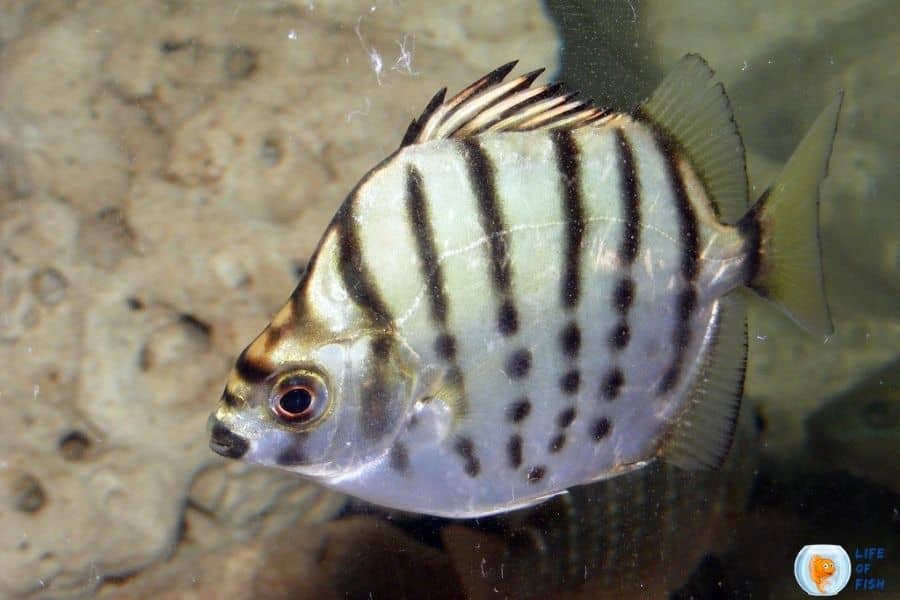
Selenotoca papuensis
Selenotoca papuensis is the smaller variation of Selenotoca multifasciata, belongs to the same genera Selenotoca.
They inhabit marine water as well as brackish and benthopelagic waters in the Western Pacific region.
This species only reach about 9cm maximum, but their life expectancy is unknown.
Among these four species, the Spotted scat is the species widespread in the aquarium trade. Therefore, from now on, we specifically explain about Spotted scat fish under scat fish care.
Scat Fish Classification
Kingdom: Animalia
Phylum: Chordata
Class: Actinopterygii
Order: Perciformes
Family: Scathophagidae
Male and female scat fish
It is not very hard to differentiate between male and female scat fish. Male scat fish has a small bump or bulge above their eye. But female fish is lack this bulge.
How big do scat fish get?
Scats can reach up to 15 inches in length and can live 10 years under optimum water conditions.
Is scat fish aggressive?
Scat fish is a peaceful fish species if they are given enough space to explore. They will do fine with friendly tank mates but can be aggressive toward aggressive tank mates.
They are also known as greedy feeders. So, they may become aggressive during feeding time.
Scat fish behavior
Scat fish are very curious fish and outgoing. They will get along with any similar-sized peaceful fish well. They rarely become afraid of things and will explore every inch of the tank.
Scats love to shoal. So, you should house more than four scats in one tank. If you keep these fish with smaller fish, shrimps, or snails, Scats may consider them as food and eat them.
Scat fish are voracious feeders that eat anything they find edible. They are omnivore fish that eat both meat-based and [plant-based food.
So, if you have plants in your aquarium, be prepared to lose them sooner or later because scats may eat plants if underfed.
Since these are very social and curious fish, you can tame them easily.
How long do scat fish live?
Scat fish can live up to 10 years both in captivity and in the wild because they are hardy fish species.
One look care guide
| Scientific name | Scatophagidae |
| Common name | Scat fish |
| Care level | Moderate |
| Native to | Southeast Asia and India |
| Type | Brackish water fish |
| Color | green, brown, silver, or red with black spots or stripes |
| Tank size | 40 gallons |
| Preferred temperature | 72-82 F |
| Other water parameters (ammonia, etc.) | pH: 7.5-8.5 Nitrate: below 20ppm General Hardness (GH): 12-18 dGH |
| Preferred salinity | 10 g per gallon (only for matured scat fish) |
| Size | 15 inches in the wild 12 inches in captivity |
| Life span | Up to 10 years |
| Temperament | Semi-Aggressive |
| Recommended tank mates | Large peaceful fish (please refer to tank mate section) |
| Preferred food | Omnivore Voracious eaters Any plant-based Meat-based food |
| Feeding frequency | Two times per day |
| Breeding | Difficult in captivity |
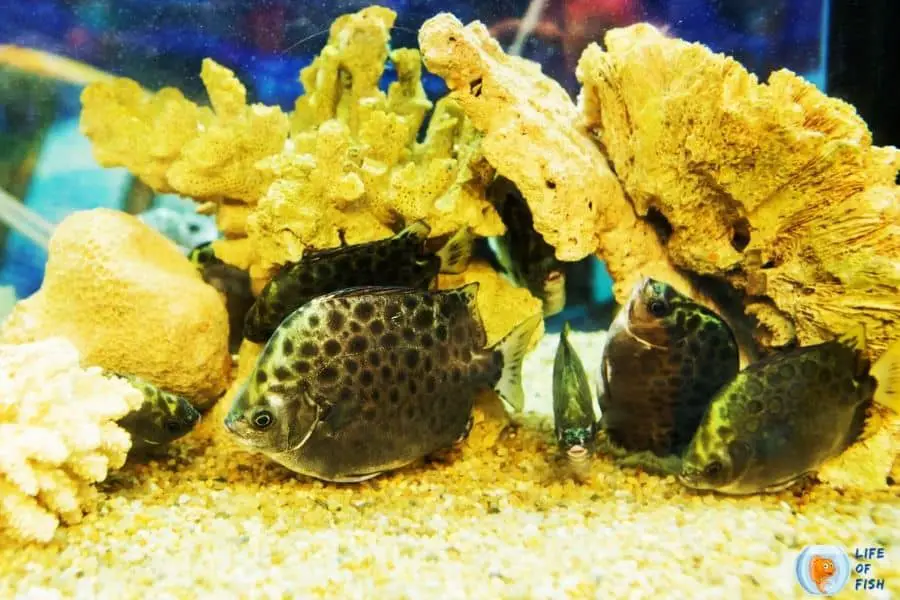
Scat fish care
Scat Fish is a hardy and colorful addition to the aquarium. Scats, like any other fish, require an aquarium environment for them to thrive.
They do best in a peaceful community of larger-sized tank mates and enjoy moderate lighting with plenty of hiding spaces provided by rocks and plants.
They are not picky eaters. However, they enjoy live brine shrimp or blood worms as a treat.
Scats are among the best scavengers for large community aquariums, but they need proper care to stay healthy.
Scat fish are intelligent and inquisitive, making them entertaining to keep in an aquarium environment, but they can also be expensive in the acquisition price and care requirements.
size
Scat fish can grow up to 15 inches in length. However, they only reach about 12 inches in captivity.
Scat fish tank size
Since these are larger fish species that live in schools, they require larger tanks for them to thrive.
Luckily, they are not very picky fish when it comes to tank size, and they can do well in smaller tanks as well.
However, if you want your Scats healthy and happy, you should give them at least 40 gallons or a bigger aquarium environment that looks more like their natural habitat.
How many scat fish should be kept together?
You should house at least four scats in one aquarium because they are very social fish species.
Tank setup
In their natural habitat Scat fish are primarily live in the middle of the water, but they will swim around all parts of the tank because of their curiosity.
Their natural habitats consist of sheltered, shallow coastal waters where they live in schools.
So, you should keep your freshwater fish in groups of at least four because these are very social fish.
Substrate
Scats are not much bottom dwellers, so you can choose any substrate you want. We recommend adding fine gravel or sand because these substrates ease up cleaning when vacuuming.
Decorations
Since these fish are very active and curious fish, you have to decorate the tank with many decorations like driftwood, branches, and roots.
Plants
Scat fish are omnivore fish, and they love to eat plants. Therefore, adding plants to your aquarium is not good unless you want them to eat the plants. A good alternative is artificial plants for aesthetic reasons.
Filtration
Scat fish are aggressive, messy eaters. Therefore, an efficient filtration system is a must-have.
Use a HOB or a canister filter for better results. Scats are very sensitive to Nitrites. Consequently, you will also have to have good biological filtration.
Lighting
Scat fish will do best with moderate lightings. So, ensure that you provide appropriate lighting in your tank.
Water quality condition
Providing ideal water conditions can be challenging for a beginner aquarist because these fish require different water conditions in various stages of their life.
Juvenile scat fish require freshwater conditions to thrive. But as they get old, they prefer brackish or saltwater conditions in their surroundings.
That is why you will most likely see these fish in estuaries because they migrate between two water bodies.
Ideal water conditions for scat fish;
pH: 7.5-8.5
Temperature: 72-82 F
Nitrate: below 20ppm
General Hardness (GH): 12-18 dGH
We recommend using a liquid test kit to ensure that you maintain the water quality in your aquarium.
If there is a need for a significant water change, use only dechlorinated water to avoid toxic build-up.
Scat fish require alkaline water conditions. Therefore keeping it stable is essential for their health.
You can put a pinch of baking soda once per week to acquire this or add a chalky substrate like aragonite, ground coral, or dolomite in your aquarium.
For juvenile fish, use fresh water in your aquarium. As they get old, acclimate them to brackish water by adding aquarium salt to the tank.
The quantity should be two teaspoons per gallon. Once they are acclimated to saltwater, do not change the salinity because they will fall sick and die.
Since these are voracious feeders, they tend to mess with the water frequently.
Therefore, you will have to vacuum the tank weekly to remove fish waste. 30% water change is enough per cleaning.
Scat fish breeding
Breeding of scat fish is difficult in captivity because they require specific saltwater conditions to spawn, and the fry needs freshwater conditions to grow up.
Providing both water conditions in one aquarium is impossible. Therefore, scat fish breeding is impossible in an aquarium setup.
The scat fishes sold at the pet shops are often wild-caught ones. Aquarists mostly catch juvenile scat fish because they are easy to acclimate into the aquarium environment.
Special tips
When handling these fish and cleaning the tank, take precautions as the dorsal fins of scats have toxins that can result in dizziness and pain in humans.
When you remove the scat from the water, hold them gently and keep them in a wet hand. Also, do not feed these fish before or after netting.
If possible, wait for 10 minutes before feeding them again to prevent bloating.
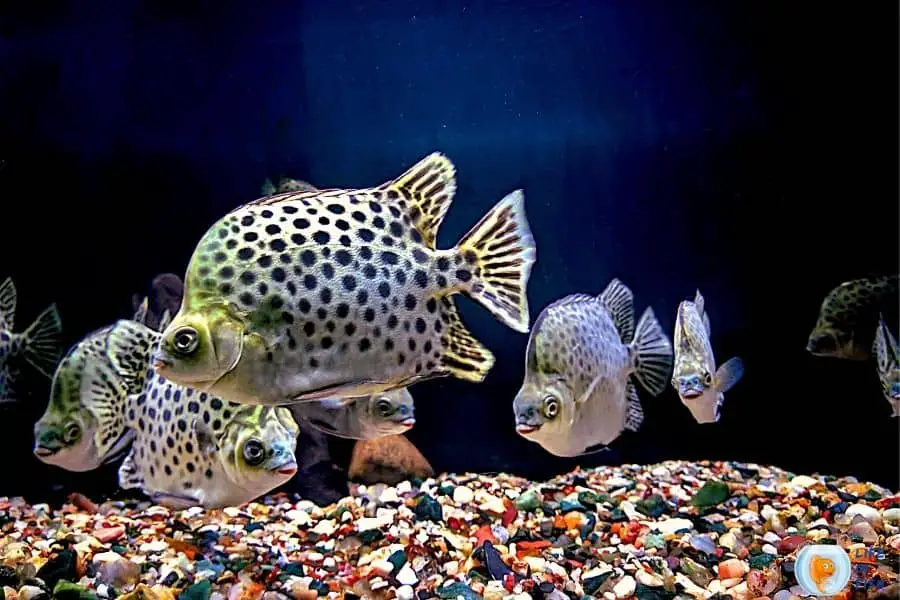
How to feed scat fish?
Scats are omnivorous and will eat everything around their habitat, including the faces of other fish species.
They mainly feed on crustaceans, worms, insects, and plant matter. You should also provide them with vitamin-enriched brine shrimp, freeze-dried worms or blood worms to prevent nutritional deficiencies in the fish.
Scats’ diet should consist mainly of vegetables and occasional meat-based food.
So, we suggest pellets and flakes that contain algae and vegetable matter and vegetables like zucchini, spinach, peas, seaweed, lettuce, and cucumbers in their primary diet.
Any meaty food like bloodworms, blackworms, brine shrimps, Mysis shrimps, and chopped prawns should be fed as occasional supplemental food.
When feeding vegetables, boil or blanch them before feeding them to the fish. This will prevent bloating in the scat fish. You can also feed them with commercial fish food.
Scats are hardy and healthy eaters if not overfed. So, prevent feeding any fish food in large quantities at all costs.
What fish can live with scat fish?
Although scat fish are peaceful with their tank mates, they become aggressive when it comes to feeding.
Therefore, you should choose their tank mates carefully. The tank mate should be neither too big nor too small.
If the fish is small enough to fit into the scat’s mouth, they will be eaten by it. And If they are too big, you can trigger a fight to the death between the tank mates.
If you want to avoid constant aggression among your fish species, ensure they don’t share food or are near each other when feeding.
You should also keep one male and two (or more) females in an aquarium, as this will reduce male-to-male aggression.
The ideal juvenile scat fish tank mates’ suggestions are orange chromites, mollies, and dwarf neon blue rainbows. Juvenile green Chromide and swordfish are also compatible with juvenile scats.
For matured scat fishes, ideal tank mates are active, peaceful, and similar-sized fish like mono angelfish, green chromide, neon blue rainbow fish, brackish water bullies, archerfish, mono sense, and orange chromides.
Do not house slow swimming fish as scats may chase down these fishes. Avoid aggressive fish as well.
Related Questions
Do scats eat plants?
Scats are omnivore fish that eat both plant matter and meat matter. In the wild, these fish mostly inhabits mangroves and estuaries with dense vegetation.
They eat vegetation such as seagrasses, algae, and freshly fallen mangrove leaves. Scats also love to chew on the leaf of aquarium plants.
Therefore, many scat fish owners use artificial plants instead of natural plants.
How long does a scat fish live?
A scat fish can live for about 5 to 10 years in captivity. However, this depends on the conditions and species of the fish.
Read Next : Archer Fish Ultimate Care Guide | 14 Interesting Facts You Should Know |
